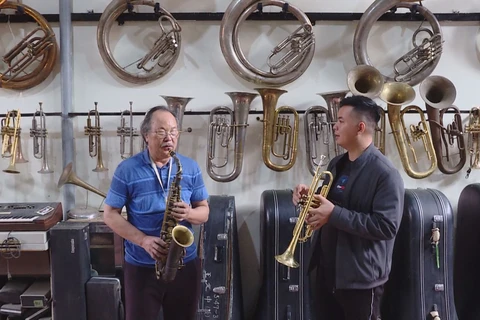 Preserving and bringing into play the old embroidery is the wish of many artisans in Dong Cuu village (Photo: VietnamPlus)
Preserving and bringing into play the old embroidery is the wish of many artisans in Dong Cuu village (Photo: VietnamPlus) Hanoi (VNA) – Dong Cuu village in Dung Tien commune of Hanoi’s outlying district of Thuong Tin has long been famous for its traditional embroidery, especially the making of royal robes for kings of feudal dynasties in Vietnam, and the craft has still been upheld nowadays.
Centuries-old craft village
Dong Cuu still possesses typical features of a village in the Red River Delta such as an ancient banyan tree and an old communal house, which stay intact today.
The village is said to have come into being in 1746 under the reign of King Le Hien Tong. Local residents worship Le Cong Hanh, the founder of their traditional embroidery. Legend has it that he learned embroidery techniques during a trip he served as an envoy to a state in the north and then passed them to people in the homeland, including Dong Cuu villagers.
Embroidering royal costumes requires meticulousness and hard work. Tools necessary for this craft are simple: needles, embroidery frames, scissors, rulers, brushes, threads, and fabrics. However, to complete the work, workshops have to find suitable types of fabric and strictly comply with complex embroidery rules.
Ms Mai, an embroiderer in Dong Cuu, said it takes several months to complete a robe while some others need an entire year. Here, all steps are done by hand so meticulousness and patience are required. For example, embroidering a king’s robe needs different techniques compared to making a queen’s one.
There are even visitors from the southern region coming to the village to see the hand embroidery, she noted.
Mai added although machine embroidery generating perfect stitches is now available, hand embroidery items are still preferred. One product created with the wholehearted care and industriousness for months always holds high aesthetic value.
Determination to keep traditional craft alive
At present, there are more than 100 households running embroidery workshops with 10 - 20 workers each in Dong Cuu. They turn out a wide range of products such as royal robes, scarves, and altar curtains which are sold across the country, especially in the north region and Hanoi capital.
It takes Dong Cuu a long period of time to take shape and get established, an achievement attributable to the creativity and efforts by many generations of locals. The village is currently home to skillful and devoted workers who are ready to pass their knowledge and skills to others, especially the young.
Many young people in Dong Cuu have engaged in this craft, which is an encouraging sign now that many traditional craft villages nationwide are facing the risk of disintegration.
Nguyen The Du, Chairman of the Traditional Embroidery Association of Dong Cuu, said the village has won the trust of many customers and received a large number of orders. Its workers earn high salaries.
To uphold the traditional craft, training has continually been provided for young people, he noted, adding that embroidery has become the main source of income and help many households get out of poverty.
The scrupulousness of veteran artisans and the dynamism and creativity of the young have helped diversify embroidery products of Dong Cuu, which helps kept the craft alive.
Given such cultural values, the Ministry of Culture, Sports and Tourism has recognised the traditional craft of Dong Cuu as part of the national intangible cultural heritage./.

























